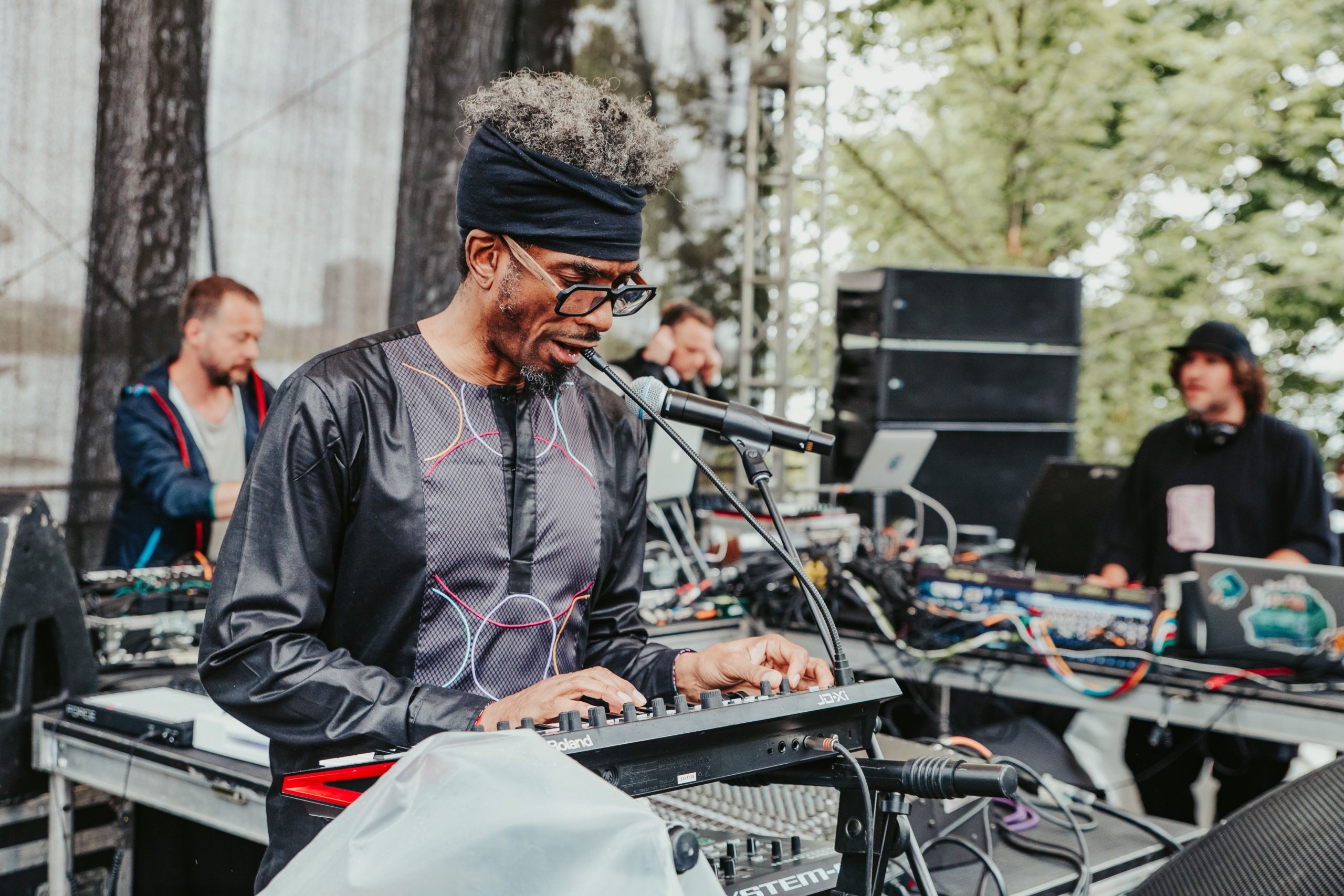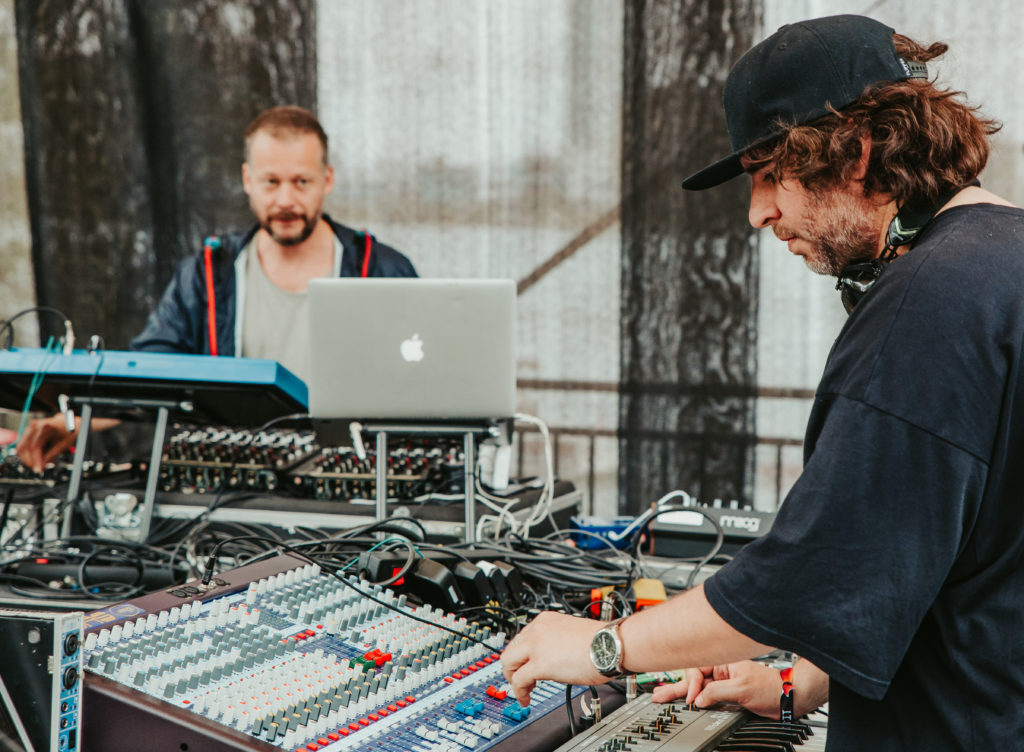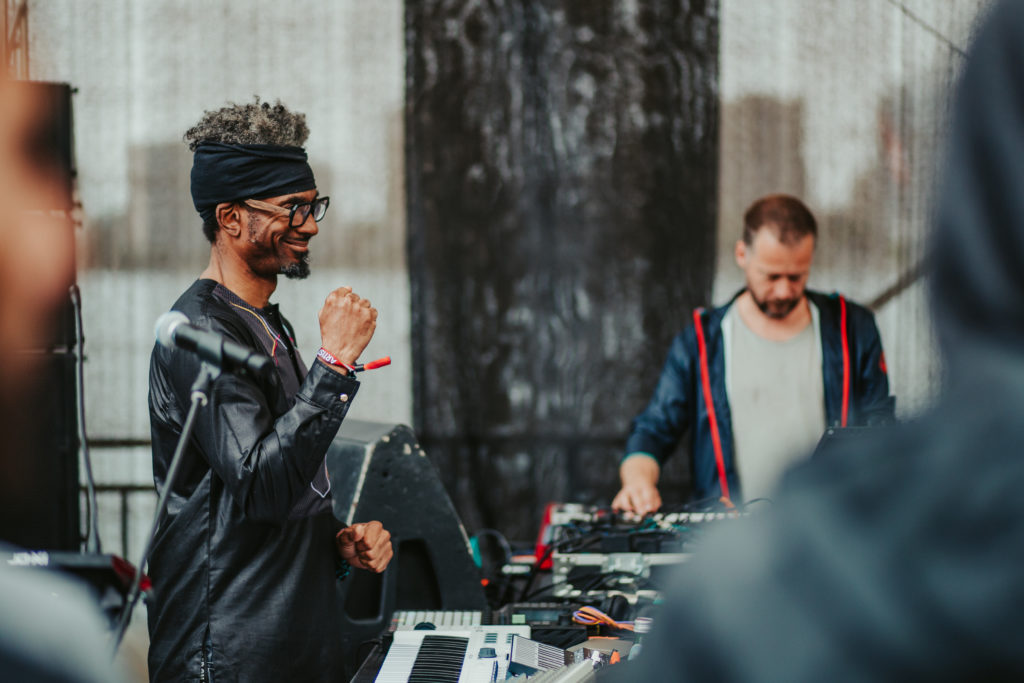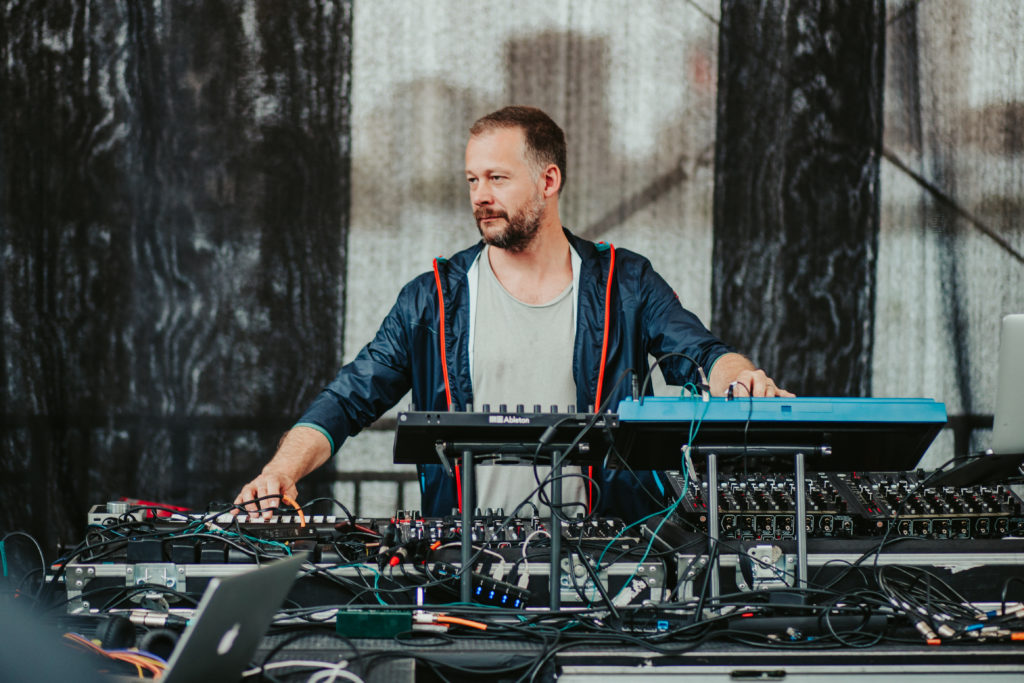Live Essentials: Circle of Live
Circle of Live, Movement Detroit 2019

Live Essentials: Circle of Live
Circle of Live, Movement Detroit 2019
Born in the European summer of 2018, Circle of Live is the work of Sebastian Mullaert, the beloved Swedish artist known for his cerebral techno soundscapes. Looking to take his sonic improvisations a little further, and recognising the untapped beauty in the sounds that artists create in the comfort of their own studios, he wished to transfer this to the live environment.
“We, as artists, can create our personal paradise to find a way to express ourselves, and then we go out on stage and it becomes separate to that. The idea came to create that also on stage,” Mullaert told Resident Advisor earlier this year. “I truly believe that if an artist feels comfortable on stage and they can relax into it, it helps the audience to do the same.”
Recruitment began soon thereafter. Calls were made to friends, and several—Âme (Live), Johanna Knutsson, Leafar Legov, etc.—signed up, and many more have joined. The Circle now comprises 19 artists, all identified and selected by Mullaert. The list, which now includes Peter Van Hoesen, Dorisburg, Steffi, and Neel, features artists from a diverse set of backgrounds and with different ways of expressing themselves, but what glues them together is an appreciation for spontaneity and improvisation.
On stage, Circle members jam in different constellations; Muallert curates a different lineup for each performance. Mullaert himself, the one constant, begins with some ambient soundscapes, before inviting the other artists to begin interacting as they wish; it’s an unhinged, freeform experience, unhindered by formal structure so as to allow both the performers and audience to explore the boundaries of electronic music improvisation in its raw beauty. These recordings, which can exceed eight hours, are then reviewed, and segments—those which best capture the essence of the project—are released through the record label of the same name, offering a snapshot into the weird and wonderful world of collaborative live performance.
Circle of Live club performances have quickly become a “must-see” in the electronic music community, and, to offer a glimpse behind the Circle, we’ve compiled a Live Essentials feature looking at the gear used by each artist at Movement Detroit 2019, where Vril made his debut appearance alongside Mathew Jonson, Amp Fiddler, and Mullaert.
Editor Note: A two-hour segment of the Circle of Live Movement jam is streaming below, and you can download it HERE as part of our XLR8R+ package alongside exclusive tracks from each artist.
“Mathew [Jonson] picked a tempo—90bpm, I picked a key (G minor, what a surprise!), Vril picked a badass gangster groove, and Amp [Fiddler] just smiled, spread his love, and started to spread the chords from his synths. How the next four hours took form no one knows, but it was an amazing journey to be part of, and listening to the first two hours, that we are sharing with you now, brings back many warm smiles to my face!”
—Sebastian Mullaert

Mathew Jonson
Victoria, Canada was a gold mine for analog synthesizers in the mid-’90s. I found the 101 alongside a JX-3P, 909, 606, and an MC-202 from a guitar player that frequented the pawnshops while on tour. Back in those days, everyone was trading in their gear for software so it was the perfect time to shop analog. That equipment was used to produce all my early records.
The 101 has still been used on more of my tracks than any other synth, and it is the only synth I feel I have truly mastered. It’s great in the studio but on stage is where it really shines due to its ergonomic interface and simple step sequencer. If you get used to programming with triggers, it is the fastest mono synth out there. On stage, I spend my time bouncing from inside the headphones programming and then switching to performance mode where I can take the sequence I have written and manipulate it multiple ways rhythmically with the triggers and sonically via the instrument.
I actually had a small part in making this piece with Roland Japan. It started on a piece of A4 paper discussing the interface design. So, having a prototype sent to me months later for testing and preset writing is not the usual way I would acquire gear. Of course, these are small compared to the original but the sound and functionality is all there. It keeps its simplicity, which is important in this unit, but it also adds polyphony, unison mode, and chord memory (which I used a lot for the Detroit recording). Amp [Fiddler] and I were really bouncing off each other between melodies and basslines in the beginning of the set before we turned the tempo up!
“In terms of the products Roland has released in the last decade, the TR-8S is my favourite.”
—Mathew Jonson
I started working with Roland shortly after the TR-8 was released. The TR-8S follow-up fulfilled all my wishes in terms of what was possible in the same format drum machine. Individual outs, trigger outputs for sequencing step sequencers and modular synthesisers, user-defined sampling capabilities for your own one-shot drum sounds, high resolution faders for volume so you can cut sounds in and out quickly with next to no latency, dedicated effects for each sound, and programmable drum sets that allow for any configuration of instruments, and an assignable knob per voice so you can choose what parameters you can affect live.
It goes much deeper, too, with in-depth control of each sound via filters, envelopes, compression, etc., in the pages beneath the first layer of workflow so you can dial things in at the studio but still have the simplicity on stage.
With Circle of Live in Detroit, I had it sequencing the rhythms of both the SH-101 and SH-01A via trigger outs, and then I had five individual outputs left for the drums. In terms of the products Roland has released in the last decade, the TR-8S is my favourite.

Amp Fiddler
The AKAi Force is a beast and works a lot like Ableton, which most of the others in the Circle of Live team use. It does everything, such as creating rhythms, beats, fast loops of keyboards, or sampling on the fly. What I don’t like is that it doesn’t have streaming of audio yet. This is my go-to piece and I could use it alone if needed without any other equipment. It has a synth engine and it’s standalone, so I never need the computer to run with it.
I got the Force from Guitar Center on Sunset in Los Angeles, and my man Andy Mac (AKAi UK), who gives me all the support I need, suggested it.
The JD-Xi is used for keyboard sounds and mostly vocoder for some space vocoder sounds. I have a Roland endorsement and received this from them direct. I’m not that fond of the small keys and I’ll soon trade it for a more portable unit like the Roland VP-03, which actually has even smaller keys unless I use a controller!
The Oberheim OB-6 is the analog beast for mashing sequences and arpeggiator shit and creating any kind of funky next-level sounds. I’m not a tech-head yet I do love electronics and synthesis, so I like keeping it simple and as live as possible with Circle of Live. I found the Oberheim here in Detroit for a great price from a local dealer, and there’s nothing I don’t like about it!
Live Essentials: Vril
Super nice distortion. Also, you can use the parametric EQs as a filter. The sound of the mixer is totally ace.
Dave Smith Instruments OB-6 (Keyboard Version)
I use it to play spontaneous strings and basslines mostly. It’s the perfect synth.
You can go on changing the sound with this one for a long time. Adds an analog feel. Also nice sub-bass loops and dirt.
Always good to have. Very easy to use onstage.
Eventide H9 Max with iPad
With the Eventide app, you can perfectly save and use the H9. That’s a special combination. But for this session, I only used a small room effect.
Akai APC40 MK2 & Novation Launch Control with Ableton
Best controller combination.

Sebastian Mullaert
“Here are five things I’ve highlighted in my live rig. Please note that this is not my studio gear but things I’ve chosen to use on stage, both solo and when I have Circle of Live jams with other people.”
— Sebastian Mullaert
My live rig is built on both hardware and software, and you can probably say that half of what I do is coming from the computer and the other half from outboard gear. Ableton Push is the heart of all my MIDI looping, inside the box and my outboard gear. All my outboard instruments are connected to the computer via MIDI so I can choose to play any synths and plug-ins with the Push or the MIDI keyboard connected to it. I can build up specific drum patterns and sequences on a synth on the fly, and also with just one touch of the finger loop a sequence I’m playing freestyle on a synth. The combination of playing freestyle and then looping parts of that is a big part of how I play live.
I don’t really see anything I don’t like with the push; there are so many features with it that I don’t use, so the only negative thing I would have to say is that there are too many menus and possibilities, but so far this hasn’t really affected me much.
All my synths, both software and hardware, have their own channels on my three Model 1 mixers. From the headphone output, I can select which channel I want to send to my external audio looper, a Boss RC-505.
Looping things MIDI and audio is different and I find them useful at different times. The MIDI looping allows me to continue tweaking the parameters of the synth or drum machine while the audio looper captures a full tweak and repeats that. Another important function is that I can ”capture” a full soundscape or loop I’m playing, take down all the original faders, and bring up the RC-505 loop and let it play while I’m creating a new track.
When we play with Circle of Live, I’ve also routed every other artist’s signal in a way that I can loop them at any time. This often creates very interesting music situations and it helps improvisation to bloom.
I love Roland and I use so many of their things, but sometimes I must say they miss out on the design: the RC-505 is just not very nice looking and I feel it’s way too big. It also takes up a lot of room in my setup; it could easily be half the size!
The Roland SH-101 is the one thing that has followed me during all the different live sets I’ve built. It’s easy and so functional, and I know it by heart. I love to mix things I know well with things that are new to me; this adds two different aspects to an improvisational jam. The main problem with the 101 is that it’s a very expensive piece of plastic and absolutely not made for touring. I have trashed quite a few over the years, and when I ask a promoter to rent one they are often not fully working.
The first time I met Vril I had a little 101 disaster. We were playing at a festival in Colombia together and to make it to the festival we had to go in a small little jet plane. It was so tight and all my gear was pushed into the actual seats. When the pilot tried to fit everything, he dropped the 101 straight onto the asphalt!
On my tech rider, I have a list of over 10 poly synths and I ask the promoter to source one of them. Everything else in my setup I bring myself, and I know very well, so having something chosen by the promoter means something is kept random, and this throws up new opportunities and challenges. I don’t use the Korg Prologue in the studio, and have just used it the times I play on stage, but I must say I really like it as a live synth. It’s easy, and sounds really good.
Another thing that makes it so good for me is that it blends with other sounds and synths, which is good when you’re improvising with loads of different artists each weekend.
I’m using three Model 1 mixers from PLAYdifferently in my live sets. This gives me a total of 48 channels. To ask for a studio desk with 48 channels would take loads of space and also give me loads of knobs that I don’t need.
The Model 1 mixers have most of the things I need in a compact size, and they’re full of analogue sound power. Two aux, eight stereo channels, one EQ sweep on each channel, plus a super nice low and high cut on each channel, amazing master filter, master EQ, DSub in and outputs, and it also has headphone outputs so I can route sounds to the looper! Also, the distortion on each channel sounds really nice when not tweaked too hard.
I’ve started to love this mixer so much and, at times, when I for some reason can’t perform with it, I feel limited. One thing I would like to change, however, is the high and low pass filters, so that they to go all the way (now you need to tweak both of them to kill the sound completely). I would also love the EG sweep to gain more than 6db!

